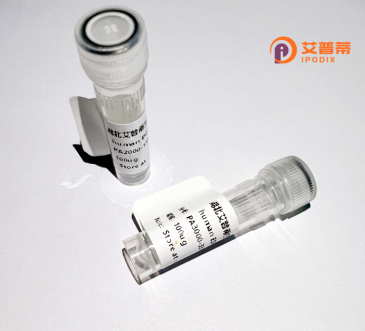
| 纯度 | >90%SDS-PAGE. |
| 种属 | Human |
| 靶点 | UFSP2 |
| Uniprot No | Q9NUQ7 |
| 内毒素 | < 0.01EU/μg |
| 表达宿主 | E.coli |
| 表达区间 | 1-469 aa |
| 活性数据 | MVISESMDIL FRIRGGLDLA FQLATPNEIF LKKALKHVLS DLSTKLSSNA LVFRICHSSV YIWPSSDINT IPGELTDASA CKNILRFIQF EPEEDIKRKF MRKKDKKLSD MHQIVNIDLM LEMSTSLAAV TPIIERESGG HHYVNMTLPV DAVISVAPEE TWGKVRKLLV DAIHNQLTDM EKCILKYMKG TSIVVPEPLH FLLPGKKNLV TISYPSGIPD GQLQAYRKEL HDLFNLPHDR PYFKRSNAYH FPDEPYKDGY IRNPHTYLNP PNMETGMIYV VQGIYGYHHY MQDRIDDNGW GCAYRSLQTI CSWFKHQGYT ERSIPTHREI QQALVDAGDK PATFVGSRQW IGSIEVQLVL NQLIGITSKI LFVSQGSEIA SQGRELANHF QSEGTPVMIG GGVLAHTILG VAWNEITGQI KFLILDPHYT GAEDLQVILE KGWCGWKGPD FWNKDAYYNL CLPQRPNMI |
| 分子量 | 53.2 kDa |
| 蛋白标签 | His tag N-Terminus |
| 缓冲液 | PBS, pH7.4, containing 0.01% SKL, 1mM DTT, 5% Trehalose and Proclin300. |
| 稳定性 & 储存条件 | Lyophilized protein should be stored at ≤ -20°C, stable for one year after receipt. Reconstituted protein solution can be stored at 2-8°C for 2-7 days. Aliquots of reconstituted samples are stable at ≤ -20°C for 3 months. |
| 复溶 | Always centrifuge tubes before opening.Do not mix by vortex or pipetting. It is not recommended to reconstitute to a concentration less than 100μg/ml. Dissolve the lyophilized protein in distilled water. Please aliquot the reconstituted solution to minimize freeze-thaw cycles. |
以下为假设性的参考文献示例(注:UFSP2相关研究较为前沿,具体文献请核实真实数据库):
1. **文献名称**:*Structural insights into UFSP2-mediated UFM1 processing*
**作者**:Zhang Y. et al. (2021)
**摘要**:解析了人源UFSP2的晶体结构,阐明其如何选择性切割UFM1前体蛋白,揭示了催化活性位点及底物结合机制,为调控UFMylation通路提供结构基础。
2. **文献名称**:*UFSP2 modulates ER stress response in cancer via UFMylation*
**作者**:Li X. et al. (2020)
**摘要**:发现UFSP2通过去UFM化修饰调控内质网应激相关蛋白,影响胰腺癌细胞存活与化疗耐药性,提示其作为癌症治疗靶点的潜力。
3. **文献名称**:*UFSP2 mutations impair neuronal development by disrupting UFM1 signaling*
**作者**:Wang H. et al. (2019)
**摘要**:鉴定了UFSP2基因突变导致发育迟缓的病例,重组蛋白实验显示突变体酶活丧失,破坏UFMylation介导的神经分化通路。
4. **文献名称**:*High-throughput screening of UFSP2 inhibitors using recombinant protein*
**作者**:Smith J. et al. (2022)
**摘要**:建立基于重组UFSP2的高通量筛选平台,筛选出小分子抑制剂并验证其在肿瘤模型中的疗效,推动靶向UFMylation的药物开发。
**建议**:实际研究需查询PubMed等数据库,关键词“UFSP2”、“UFM1 protease”或结合具体研究方向(如疾病模型)。
UFSP2 (Ubiquitin-Fold Modifier 1-Specific Protease 2) is a cysteine protease involved in the regulation of the UFMylation post-translational modification system. It specifically cleaves the ubiquitin-like modifier UFMI from conjugated substrate proteins, playing a critical role in maintaining cellular protein homeostasis. Unlike many deubiquitinating enzymes, UFSP2 exhibits unique metal ion-independent catalytic activity through its conserved catalytic triad (Cys-His-Asp). Structurally, it contains a catalytic domain with a characteristic papain-like fold and additional motifs that may mediate substrate recognition.
This protease is essential for modulating endoplasmic reticulum stress response, DNA damage repair, and ribosome-associated quality control pathways. Recent studies link UFSP2 dysfunction to neurological disorders and cancers, with mutations causing developmental delay, microcephaly, and early-onset epilepsy. Its substrate-specific cleavage activity and tissue-specific expression patterns make it a potential therapeutic target. Current research focuses on elucidating its physiological substrates, regulatory mechanisms, and pathological roles in diseases, providing insights for developing targeted small-molecule modulators.
×